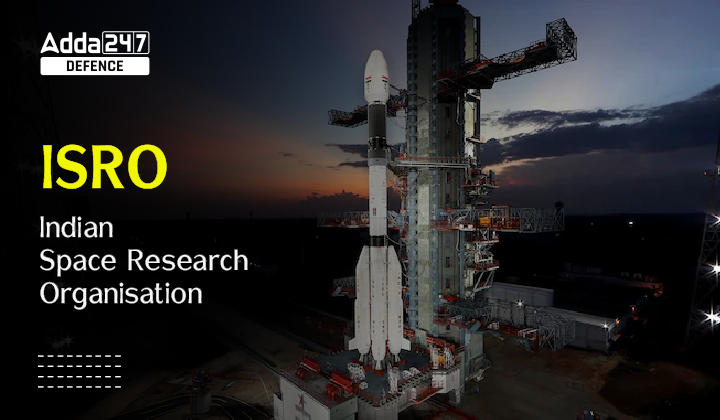ISRO, or the Indian Space Research Organization, was founded in 1969 with the principal objective of advancing space science and planetary exploration through research. One of ISRO’s noteworthy achievements was the successful development and launch of India’s first satellite, Aryabhatta, in 1975, achieved in collaboration with the Soviet space agency Interkosmos. Over the years, ISRO has demonstrated a commitment to innovation by launching numerous satellites for diverse purposes, including communication, earth observation, navigation, meteorology, and more.
ISRO Full Form
ISRO Full Form: The full form of ISRO is Indian Space Research Organization, it is one of the pioneer Organizations in the world and has earned enough name and fame for its various Missions, the era we live in today is of scientific and technological advancements, the power of a country is synonymous with the innovation and inventions it has in its account and in such times if we say ISRO is Temple of Modern India then it wouldn’t be wrong, Let’s find out more about the venerated Organization of India.
ISRO Full Form Headquarter
The headquarters of the Indian Space Research Organisation (ISRO) is located in Bengaluru (Bangalore), Karnataka, India. The exact address is:
ISRO Headquarters
Antariksh Bhavan, New BEL Road
Bengaluru, Karnataka, India
ISRO Full Form in Hindi-इसरो फुल फॉर्म हिंदी में
इसरो, यानी भारतीय अंतरिक्ष अनुसंधान संगठन, भारत का मुख्य अंतरिक्ष एजेंसी है जिसे 1969 में स्थापित किया गया था। यह अंतरिक्ष विज्ञान और ग्रह अन्वेषण के क्षेत्र में अग्रणी अनुसंधान का कार्य करता है। इसरो ने अपनी पहली उपग्रह, जिसे आर्यभट कहा जाता है, बनाया था, जिसको 1975 में सोवियत अंतरिक्ष एजेंसी इंटरकोस्मोस के साथ साझा करके उड़ान भराई थी
ISRO Objective
Its primary objective is to harness space technology and its applications for the benefit of India and humankind as a whole. ISRO strives to develop and launch space missions, satellites, and associated technologies to facilitate various scientific, technological, and societal applications.
Chandrayaan 3 Launched by ISRO
Chandrayaan-3 represents a continuation of the Chandrayaan-2 mission, aiming to showcase a complete ability for a secure lunar landing and surface exploration. This mission comprises a Lander and Rover setup and was initiated using the LVM3 launcher from SDSC SHAR in Sriharikota.
- The propulsion module is equipped with the Spectro-polarimetry of Habitable Planet Earth (SHAPE) instrument, designed for analyzing Earth’s spectral and polarimetric characteristics from its lunar orbit.
- The Geosynchronous Satellite Launch Vehicle (GSLV), commonly referred to as Launch Vehicle Mark III, serves as the launch vehicle for the moon lander Vikram. This launcher has a height of approximately 5 meters.
- ISRO has implemented certain enhancements to enhance the reliability of Chandrayaan-3 compared to its predecessor.
- Chandrayaan-3 is composed of three key components: the Lander Vikram, named in honor of Vikram Sarabhai, the Rover Pragyan, and a propulsion module.
- Notably, the weight of the Vikram Lander has been augmented by 280 kilograms from its previous iteration, and it now carries a greater amount of fuel to ensure it stays on its designated trajectory to reach the Moon’s surface accurately.
The Journey of ISRO
The inspiring journey of ISRO began with the establishment of the space committee by Dr. Vikram Sarabhai in 1962. In 1963, India achieved a significant milestone by launching its first-ever rocket from Kerala, overcoming challenges such as transporting rocket parts on bullock carts and cycles.
- The formal establishment of the Indian Space Research Organization (ISRO) took place in 1969, carrying the aspirations of millions.
- A crucial moment arrived in 1975 when India successfully launched its maiden satellite, Aryabhatta.
- ISRO’s journey has been marked by determination, resilience, and a spirit of winning, making it a globally recognized premier institute in space research.
ISRO Budget 2023-24
The Department of Space has witnessed an 8% reduction in expenditure in the 2023-24 Union Budget, with the allocation decreasing to ₹12,543.91 crore compared to the previous budget estimate of ₹13,700 crore. However, it is worth noting that this revised allocation is still 19% higher than the expenditure in the last fiscal year.
- Significantly, the budget for space science, encompassing missions led by the Indian Space Research Organisation (ISRO) such as Chandrayaan 3, Aditya L1, and the Climate and Atmospheric Programme, has experienced a nominal decrease of 32% when compared to the previous budget estimate.
- ISRO is expected to make substantial progress towards achieving 84% human spaceflight capability for its Gaganyaan mission in the fiscal year 2023-24.
- Additionally, the organization plans to launch 13 satellites through four Polar Satellite Launch Vehicle (PSLV) missions, three satellites through two Geosynchronous Satellite Launch Vehicle (GSLV) missions, and one satellite using its new Small Satellite Launch Vehicle (SSLV) rocket. These missions are projected to generate a commercial revenue of approximately ₹331.5 crore.
- On a positive note, the INSAT satellite system has received a notable increase of ₹112 crore in its allocation. It is anticipated that the system will generate a revenue of ₹445 crore in the fiscal year 2023-2024 by providing satellite communication (satcom) services.
These financial allocations and projections indicate a nuanced approach towards budgetary planning for the Department of Space, with certain areas experiencing reductions while others receive boosts. The focus on human spaceflight, satellite launches, and satcom services demonstrates the diverse priorities and ambitions of the Indian space program in the coming fiscal year.
Check: SSB Full Form
ISRO Capacity
The Indian Space Research Organisation (ISRO) has announced that it has increased the payload capacity of its LVM3 (GSLV MkIII) rocket by 450 kg by loading additional propellant into its indigenous cryogenic engine CE20. ISRO further stated that the CE20 cryogenic engine, designed for LVM3, underwent a successful hot test on November 9, 2022, operating at an upgraded thrust level of 21.8 tonnes for the first time.
ISRO Achievements
There is no denying the fact that ISRO has never failed in bringing glory and pride to India and proving the supremacy of India in space technology. Listed below are some of the most memorable experiences ISRO has given us
- ARYABHATTA: It was the beginning of the ISRO’s story of achievements, in the year 1975 India became one of the few countries to launch their man-made satellites in space.
- THE BALLOON EXPERIMENT: The Balloon experiment gained popularity as it led to the discovery of three Bacteria which are found in the Stratosphere.
- MARS ORBITER MISSION: On 5 November 2013 India made history by becoming the first country to successfully launch its orbiter craft in the very first attempt and that too in a budget of a Hollywood movie.
- LAUNCHING OF 104 SATELLITES: In Feb 2017 India set a record for launching the maximum number of satellites in a single rocket however the record was later broken by some other country.
- ANNOUNCEMENT OF GAGANYAAN PROGRAMME – In the Independence Day address – 2018, the Hon’ble Prime Minister announced the “Gaganyaan Programme”, marking India’s foray into the new age of human space exploration.
- GSAT-29 – GSAT-29 high throughput communication satellite was successfully launched on November 14, 2018, on-board GSLV Mk III-D2. It is providing satellite-based connectivity to Jammu & Kashmir and the North Eastern regions of India.
- GSAT-11 – In 2018, ISRO’s next-generation high throughput communication satellite, GSAT-11 was successfully launched on December 05, 2018, from Kourou, French Guiana by Ariane-5 VA-246. Weighing about 5854 kg, GSAT-11 is the heaviest satellite built by ISRO.
- CHANDRAYAAN 2 – India’s second mission to Moon, Chandrayaan-2 was successfully launched on July 22, 2019, onboard GSLV Mk III-M1, the first operational flight of this new launch vehicle. Chandrayaan-2 Orbiter is providing valuable scientific data for the research community.
- PSLV-C48/ RISAT-2BR1 – The launch of PSLV-C48/ RISAT-2BR1 in Dec 2019 marked the 50th launch of PSLV, the workhorse launch vehicle.
- QUANTUM KEY DISTRIBUTION (QKD) – Quantum entanglement-based real-time Quantum Key Distribution (QKD) over a 300m atmospheric channel along with quantum-secure text, image transmission and quantum-assisted two-way video calling was demonstrated on 27 January 2022.
- IS4OM – The Hon’ble Minister of State (Department of Space) dedicated ISRO System for Safe & Sustained Operations Management (IS4OM) to the nation in Jul-2022.
- LVM3 (GSLV MkIII) M2/OneWeb India-1 Mission was successfully accomplished on 23rd October 2022. With this launch, LVM3 exemplifies Atmanirbharata and enhances India’s competitive edge in the global commercial launch service market.
- IMAT – As part of the Gaganyaan programme, a new Test Vehicle for testing critical systems is developed. ‘Integrated Main Parachute Airdrop Test (IMAT)’ of the crew module deceleration system was successfully carried out at Babina Field Fire Range (BFFR), Jhansi, Uttar Pradesh on 18th November 2022.
- IAD – ISRO successfully demonstrated new technology with Inflatable Aerodynamic Decelerator (IAD) – a game changer with multiple applications for future missions.
- LAUNCHING OF VARIOUS SATELLITTES – Recently, PSLV-C54 successfully launched the EOS-06 satellite on 26th November 2022 along with Eight Nano-satellites including INDIA-BHUTAN SAT (INS-2B).
ISRO Full Form in Hindi
भारतीय अंतरिक्ष अनुसंधान संगठन है| यह दुनिया में अग्रणी संगठन में से एक है, और इसने अपने विभिन्न मिशनों के लिए पर्याप्त नाम और प्रसिद्धि अर्जित की है, आज हम जिस युग में जी रहे हैं वह वैज्ञानिक और तकनीकी प्रगति का है, एक देश की शक्ति नवाचार और आविष्कारों का पर्याय है। इसके खाते में और ऐसे समय में अगर हम कहते हैं कि इसरो आधुनिक भारत का मंदिर है तो यह गलत नहीं होगा.
आईएसआरओ ने कई महत्वपूर्ण मिशनों को सफलतापूर्वक पूरा किया है। इसमें भारतीय सूर्यमंडलीय अनुसंधान संगठन (इसपीओ) के माध्यम से विज्ञान मिशनों का आयोजन शामिल है, जिनमें चंद्रयान-१, चंद्रयान-२, मंगलयान-१, और अदित्य-ल१ शामिल हैं। इन मिशनों ने भूकम्पीय और मौसमी तथ्यों का अध्ययन करने, अंतरिक्ष संचार के लिए उपयुक्त सैटेलाइट नेटवर्क तैयार करने, सूर्य की तापमान में अध्ययन करने, और विभिन्न उपग्रहों को लॉन्च करने में महत्वपूर्ण योगदान दिया है। इन उपलब्धियों ने न केवल भारत को अंतरिक्ष अन्वेषण के क्षेत्र में मजबूती दी है बल्कि वैज्ञानिक ज्ञान और प्रौद्योगिकी में महत्वपूर्ण योगदान भी किया है।
Now keep yourself updated with Latest Defence Jobs and News 24×7 Download ADDA247 App Now! CLICK HERE



 CISF Full Form, Know About History and F...
CISF Full Form, Know About History and F...
 CRPF Full Form, History, Roles and Respo...
CRPF Full Form, History, Roles and Respo...
 NCC Full Form, Know About History and Ai...
NCC Full Form, Know About History and Ai...
